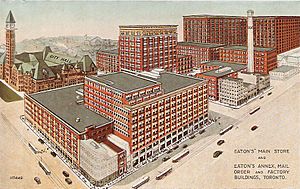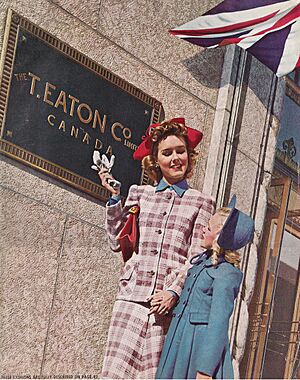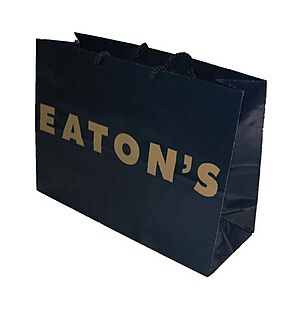Eaton's facts for kids
 |
|
|
Trade name
|
Eaton's |
|---|---|
| Private (1869–1998) Public (1998–1999) |
|
| Industry | Retail (department store) |
| Fate | Filed for bankruptcy; assets were purchased by Sears Canada in 1999. Stores converted to Sears stores or shut down in 2002. |
| Successor | Sears Canada |
| Founded | 1869 |
| Founder | Timothy Eaton |
| Defunct | 1999 as a company 2002 as a brand |
| Headquarters | Toronto, Ontario (with stores across Canada) |
|
Key people
|
Timothy Eaton John Craig Eaton John David Eaton |
|
Number of employees
|
70,000 |
Eaton's was a famous Canadian department store chain. It was once the biggest store of its kind in the country. Timothy Eaton, who came from what is now Northern Ireland, started the company in Toronto in 1869.
Eaton's became a very important part of Canadian life. It had stores all over the country and offices around the world. Many Canadian homes also had its mail-order catalog. But by the late 1900s, shopping habits changed, and the company faced problems. It went out of business in 1999.
Eaton's was known for new ideas in shopping. Back when people usually argued about prices, Eaton's had a clear rule: "We propose to sell our goods for CASH ONLY – In selling goods, to have only one price." They also promised "Goods Satisfactory or Money Refunded," meaning you could get your money back if you weren't happy.
Contents
Early Years of Eaton's
In 1869, Timothy Eaton sold his share in a small store in St. Marys, Ontario. He then bought a new business in Toronto at 178 Yonge Street. This was his first Eaton's store.
The first store was quite small, only about 24 by 60 feet. It was also a bit far from the main shopping area in Toronto. People didn't think a store that only took cash and had fixed prices would do well. But it did!
The business grew quickly. In 1883, Eaton moved to a much bigger store at 190 Yonge Street. This new store was amazing for its time. It had the largest windows in Toronto and was the first Canadian store with electric lights. It had three floors of shopping and even an elevator, which was very new for stores back then.
Eaton's had a big rival, Simpson's, another department store. Their stores faced each other across Queen Street West in Toronto. For many years, thousands of shoppers would cross the street between Eaton's and Simpson's to compare prices.
By 1896, Eaton's called itself "Canada's Greatest Store." The company kept getting bigger, adding buildings for its mail-order business and factories. By 1911, Eaton's employed 17,500 people. By 1919, the Eaton's buildings in Toronto covered a huge area, like 60 acres of floor space.
The Winnipeg Store
At the start of the 1900s, Eaton's did a lot of business in Western Canada through its catalogue. So, they decided to build a large warehouse in Winnipeg, Manitoba, to send out catalogue orders faster.
Timothy Eaton's son, John Craig Eaton, convinced his father to also build a store in Winnipeg. Even though it was far from Toronto, Timothy agreed. The big five-storey Eaton's store opened in Winnipeg on July 15, 1905. Timothy Eaton himself was there for the opening.
This red brick store was called "the Big Store" by people in Winnipeg. It was very successful. It started with 750 staff and quickly grew to 1,200. By 1919, Eaton's in Winnipeg had 8,000 employees.
For many years, the Winnipeg Eaton's store was one of the most successful department stores in the world. People in Winnipeg spent a lot of their shopping money at Eaton's. On a busy day, one out of every ten people in Winnipeg would visit the store.
The Winnipeg store, along with 36 other Eaton's stores, closed on October 17, 1999.
Overseas Offices
Eaton's had offices in Europe to buy goods. They opened one in London, England, in 1892 and another in Paris, France, in 1898.
Canada's Top Retailer
Eaton's success changed how department stores worked in North America. American store owners came to see the Eaton's stores to learn their methods. Until the 1950s, Eaton's called itself the "largest retail organization in the British Empire."
Timothy Eaton passed away in 1907. His son, John Craig Eaton, took over as president. The company continued to do very well.
In 1925, Eaton's bought a store in Montreal. By 1927, Montreal had a new six-storey Eaton's store on Saint Catherine Street. Over time, Eaton's opened stores in many other cities across Canada. They also sold their own brands of products, like an "Eaton's" typewriter.
In 1977, the Toronto Eaton Centre opened in downtown Toronto. This huge shopping complex had 200 stores and was connected to a nine-storey Eaton's store.
Eaton's also sold home appliances under the "Viking" name. Many products were sold with the brand name "TECO," which stood for Timothy Eaton Company.
The Eaton's Catalogue
The first Eaton's catalogue was a small, 34-page book published in 1884. As Eaton's grew, so did the catalogue. By 1920, Eaton's had large warehouses in Winnipeg, Toronto, and Moncton just for catalogue orders.
Back then, many Canadians lived in small, isolated towns. The Eaton's catalogue was very important because it offered a huge selection of goods that weren't available locally. It was like the Sears Roebuck catalog in the United States. You could buy almost anything from the catalogue, from clothes to farm tools. Some people even bought materials to build their homes from the catalogue! Many of these "catalogue homes" still exist today, especially in Western Canada.
The catalogue became a famous part of Canadian culture. It even appeared in many Canadian stories. In Roch Carrier's story The Hockey Sweater, a young boy from Quebec wants a Montreal Canadiens hockey jersey from the Eaton's catalogue. But he gets a Toronto Maple Leafs jersey instead.
Over time, the catalogue became less profitable. By the 1970s, it was losing money. More Canadians were moving to cities and had local stores to shop at. They didn't need the catalogue as much.
On January 14, 1976, Eaton's announced that the spring-summer 1976 catalogue would be their last. About 9,000 mail-order employees lost their jobs, and many Eaton's catalogue stores in smaller towns closed. Many Canadians were very sad about this.
The Toronto Santa Claus Parade
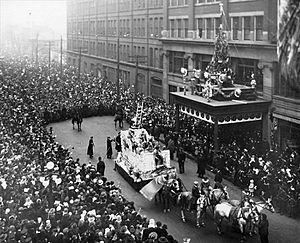
Eaton's also sponsored the yearly Eaton's Santa Claus Parade in Toronto. The first parade was held on December 2, 1905. For some years, Eaton's also held Santa Claus Parades in Winnipeg and Montreal.
By the 1950s, the Toronto parade was the biggest in North America. It was broadcast live on radio and TV in Canada and even in the United States.
To promote the parade, Eaton's created a sad little bear character named Punkinhead. Punkinhead became Santa's helper and was part of the parade for many years.
In August 1982, Eaton's announced they would no longer sponsor the parade because it was too expensive. But a group of local businesses stepped in to save the parade, and it still happens every year.
Decline of Eaton's
Unsuccessful Expansion
In the 1970s, Eaton's tried to open a chain of discount stores called Horizon. But this chain closed in 1978.
Eaton's also helped build downtown malls in smaller cities, hoping to make those areas popular again. These malls were often called "Eaton Centre." But many of these malls, in cities like Sarnia and Guelph, had empty stores and few shoppers. This added to Eaton's money problems.
Competition from Other Stores
The economy faced problems in the early 1980s, which hurt Eaton's. Other stores like Hudson's Bay Company, Sears Canada, and Zellers started to take away Eaton's customers. By the 1990s, big American stores like Walmart came to Canada, making it even harder for Eaton's to compete.
Shopping habits were changing. Large "big-box" stores like Walmart and specialty stores became more popular. Traditional department stores like Eaton's were losing their share of sales. Also, downtown shopping areas, where Eaton's was usually the main store, had to share customers with growing suburban malls.
Family Mismanagement
Eaton's problems weren't just from outside. The last two generations of the Eaton family who ran the company made some poor decisions. Stores that were once famous landmarks were not updated. New Eaton's stores built after the 1960s looked like any other chain store, making Eaton's less special.
Ending the catalogue and the Santa Claus parades saved money, but it also meant Eaton's lost its special place in the hearts of Canadians.
Eaton's was once known for great customer service, with staff called "Eatonians." But they started cutting back on staff and training to save money. The store that once offered unique goods from around the world started to have old ways of getting products and a confusing mix of merchandise.
In a very bad move in 1991, Eaton's tried a "Everyday Value Pricing" strategy. This meant they stopped all sales and discounts, even their famous "Trans-Canada Sale." This plan quickly made customers leave, but it was kept for four years before being stopped.
Bankruptcy
In 1930, Eaton's controlled almost 60% of all department store sales in Canada. By 1997, this had dropped to just 10.6%. The T. Eaton Co. first asked for bankruptcy protection in 1997. At that time, the company had about 24,500 employees and over 90 stores. They planned to close 31 stores that weren't doing well.
In 1998, the company became public for the first time, selling shares to people. But the Eaton family still owned most of the company.
The chain finally closed in 1999 after 130 years. Even after closing some stores, it lost $72 million in 1998. The company went bankrupt in August 1999. It had 64 department stores, two home stores, and one warehouse left.
By late October 1999, almost all Eaton's stores had sold off their remaining goods and closed. Only a few suburban stores were left, run by Sears Canada, while they waited to officially buy them.
Sears Buys Eaton's
In September 1999, Sears Canada bought all of T. Eaton Co.'s shares, eight of its stores, and the Eaton's name, brands, and website for $30 million. Sears had big plans for the Eaton's stores it bought. They wanted to add spas, entertainment, food, and personal shoppers. They also planned to bring back the Eaton's catalogue and website.
However, Sears had trouble getting famous brands to sell in the new Eaton's stores. This was partly because of Eaton's bankruptcy. Also, some doubted if Sears could run a high-end store, as their own products were usually cheaper. The president of a rival store, The Bay, even warned suppliers not to sell to the new Eaton's. Many brands were afraid and avoided the new Eaton's.
The new Eaton's stores were supposed to open in September 2000, but they were delayed several times, finally opening on November 25. This meant they missed much of the important holiday shopping season. The stores opened unfinished, and renovations continued into 2001.
The experiment with the seven Eaton's stores was not successful. By March 2001, Sears announced they were stopping the new Eaton's catalogue because of "lack of interest." In 2002, Sears decided to stop using the "Eaton's" name completely.
Of the seven stores, those in Winnipeg and Victoria were sold to The Bay. The Yorkdale location was redeveloped for smaller stores. The other four stores were rebranded as Sears. However, all these Sears stores eventually closed between 2008 and 2015 as Sears itself faced problems.
Sears Canada continued to struggle and eventually went out of business on January 14, 2018. It faced the same fate as Eaton's had 19 years earlier.
Eaton's Legacy
Eaton's changed shopping in Canada, and its ideas were copied by stores around the world. Many ways of selling and serving customers that we see today were first made popular by Timothy Eaton.
Many Canadians, especially older ones, have good memories of Eaton's stores and the catalogue. Few closed companies bring up such strong feelings among Canadians as Eaton's does.
Two shopping centers in Canada are still called Eaton Centres: the Toronto Eaton Centre and the Montreal Eaton Centre. The Toronto Eaton Centre is a popular place for tourists, with over a million visitors each week.
Architecture
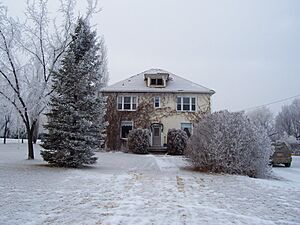
Eaton's left behind many important buildings. Eaton's College Street in Toronto, opened in 1930, is a beautiful Art Deco building. It is now used for shops, offices, and homes. The Seventh Floor, which had the Eaton Auditorium and Round Room restaurant, has been restored and is now an event space called The Carlu.
The old downtown Eaton's store in Montreal is also a landmark. It is now part of the Montreal Eaton Centre. The famous Ninth Floor Restaurant in that building, which was closed since 1999, reopened in 2024. It is protected as a historical site because of its Art Deco design.
Another old Eaton's store in downtown Saskatoon is now used as offices for the Saskatoon Board of Education. The long-time downtown Calgary store was mostly torn down in 1988, but two parts of its outer walls were saved and used in a new Holt Renfrew store.
The original downtown Vancouver store is now part of Simon Fraser University. Some people in Vancouver remember it as the Spencer's Department Store, which built it, rather than Eaton's, which bought Spencer's in 1948.
Not all Eaton's stores were architectural landmarks. Stores built from the 1960s onwards were often less special. For example, the Toronto Eaton Centre store was a large, plain box.
After Eaton's closed, most stores were changed into other shops or used for other purposes. The downtown Winnipeg store caused the most discussion. After it closed in 1999, many ideas for the building were considered, but none worked out. After a big public debate, the store was torn down in 2002 to build a hockey arena, the MTS Centre. As a nod to history, red bricks were used in the arena's design to remember the Eaton's store.
Timothy Eaton Statue
In 1919, employees of Eaton's gave two life-sized statues of Timothy Eaton to the Toronto and Winnipeg stores. This was to celebrate the company's 50th anniversary. The Toronto statue is now at the Royal Ontario Museum.
The Winnipeg statue was moved to the Polo Park Mall for a few years after 1999. But when The Bay opened a store there, they wanted the statue of their old competitor removed. After some discussion, the Manitoba government declared it a provincial heritage object. It is now in the city's main arena, Canada Life Centre. People often rub the toe of the statue's left shoe because they believe it brings good luck. That's why the toe is much shinier than the rest of the statue.
Catalogue Revival Attempt
In 2008, there was talk that Sears Canada might bring back the Eaton's brand, possibly with an online catalogue. They even applied for new trademarks using the name "Timothy Eaton." However, this plan didn't go through, and the trademark was given up by 2013.
In 2016, Sears Canada sold the remaining Eaton's brand rights to a company connected with Cadillac Fairview, which owns the Toronto Eaton Centre.
See also
- List of Canadian department stores
Suggested Reading
- Anderson, Carol and Mallison, Katharine, Lunch With Lady Eaton: Inside the Dining Rooms of a Nation, Toronto: ECW Press, 2004.
- Gourluck, Russ, A Store Like No Other: Eaton's of Winnipeg, Winnipeg: Great Plains Publications, 2004.
- McQueen, Rod, The Eatons: The Rise and Fall of Canada's Royal Family, Toronto: Stoddart, 1998.
- Santink, Joy L., Timothy Eaton and the Rise of His Department Store, Toronto: University of Toronto Press, 1990.



